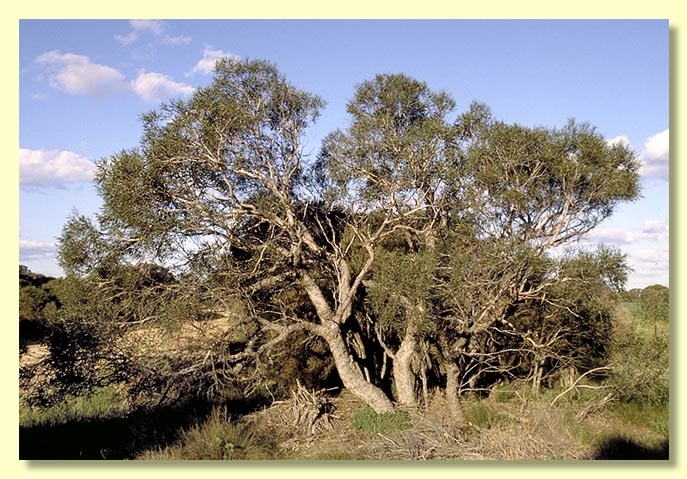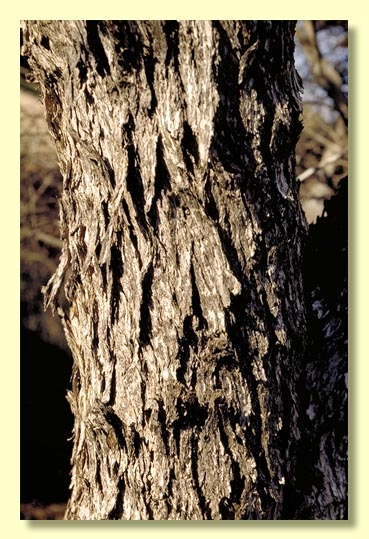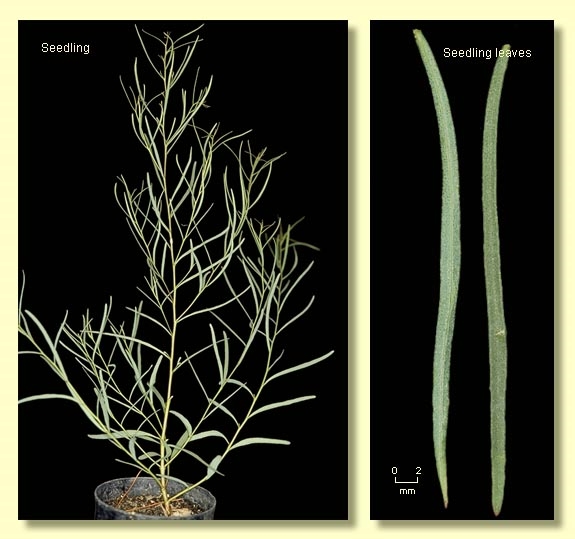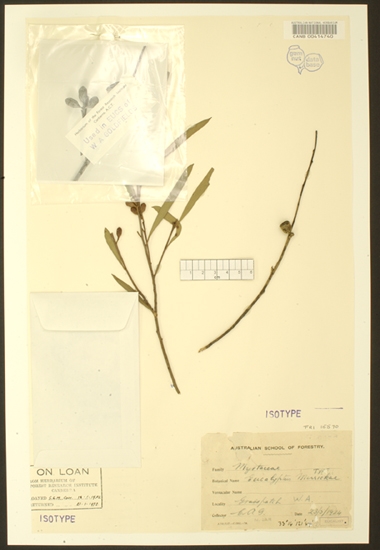Eucalyptus | Symphyomyrtus | Dumaria | Merrickianae
Euclid - Online edition
Eucalyptus merrickiae
Bark rough and flaky, light grey-brown or grey-yellow, for part or all of trunks and base of larger branches, smooth above light grey.
Branchlets have oil glands in the pith, though sometimes small or obscure.
Juvenile growth (coppice or field seedlings to 50 cm): not seen.
Adult leaves stiff, erect, alternate, petioles 0.4–0.8 cm long; blade linear, 5–8.5 cm long, 0.4–0.8 cm wide, base tapering to petiole, margin entire, apex pointed, concolorous, dull greyish green weathering to glossy green, side-veins acute or side-veins and reticulation obscured by numerous island oil glands, intramarginal vein near margin or obscure.
Inflorescence axillary unbranched, peduncles 0.2–0.5 cm long, buds 3, normally shortly pedicellate, rarely sessile, pedicels 0–0.1 cm long. Mature buds cylindrical or slightly flared below operculum (0.7–1.2 cm long, 0.5–0.6 cm wide), scar present, operculum conical or rounded, sometimes apiculate (0.25–0.5 cm long), stamens inflexed, anthers oblong to narrowly wedge-shaped, versatile, dorsifixed, dehiscing by longitudinal slits, style long and straight, stigma rounded to tapered, locules 4, the placentae each with 4 vertical rows of ovules. Flowers creamy white.
Fruit normally shortly pedicellate, rarely sessile, pedicels 0–0.1 cm long, cylindrical, 0.6–1 cm long, 0.6–0.8 cm wide, disc descending, valves 4, enclosed or near rim level.
Seeds ornamentation whitish to translucent over brown background, 1.5–2.5 mm long, ovoid or flattened ovoid, dorsal surface pitted below the ornamentation, hilum ventral.
Cultivated seedlings (measured at ca node 10): cotyledons reniform; stems rounded in cross-section; leaves sessile to subsessile for at least 17 nodes, opposite for ca 4 or 5 nodes then alternate, linear, 4–8 cm long, 0.1–0.4 cm wide, dull, grey-green to green.
Flowering has been recorded in November.
The species may have a use in salinity reclamation.
A mallee from southern Western Australia, restricted to an area just north of Esperance, east of Truslove extending to north of Mt Ridley, often on white sand near salt lakes. The bark is rough and the crown dense, with erect linear adult leaves.
Eucalyptus merrickiae belongs in Eucalyptus subgenus Symphyomyrtus section Dumaria because the buds have two opercula, stamens are strongly inflexed, ovules are in four rows on the placentae and cotyledons are reniform. Within section Dumaria it is closely related to only one species, E. surgens, and these two species, with their pitted, ornamented seed, erect leaves, glandular pith, erect inflorescences with stout shortly pedicellate cylindrical buds, constitute the small series Merrickianae.
E. merrickiae differs from E. surgens in having extensive rough bark, much more robust habit and linear seedling leaves. Specimens of intermediate character between E. merrickiae and E. surgens have been collected north-west of Israelite Bay.
Another anomalous species in section Dumaria, E. deflexa, has similar seeds to both E. merrickiae and E. surgens but is otherwise dissimilar being a small smooth-barked mallee with conspicuous pendulous cream buds.


















